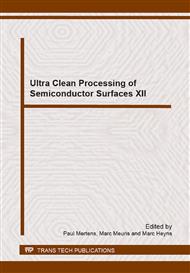p.193
p.197
p.201
p.205
p.209
p.213
p.217
p.221
p.225
TiN Hard Mask Cleans with SC1 Solutions, for 64nm Pitch BEOL Patterning
Abstract:
Titanium Nitride metal hard mask was first introduced for BEOL patterning at 65 nm [1] and 45 nm nodes [2]. Indeed, in this “Trench First Hard Mask” (TFHM) backend architecture, the dual hard mask stack (SiO2 & TiN) allows a minimized exposure of ULK materials to damaging plasma chemistries, both for line/via etch sequence, and lithography reworks operations. This integration scheme was successfully used for a BEOL pitch down to 90 nm for the 28 nm node, however, for the 14 nm technology node, 64 nm BEOL minimum pitch is required for the first metal levels. Because it is unable to resolve features below 80 nm pitch in a single exposure, conventional 193 nm immersion lithography must be associated with dual patterning schemes, so called Lithography-Etch-Lithography-Etch (LELE) patterning [3] for line levels and self-aligned via (SAV) process [4] for via patterning. In both cases, 2 lithography/etch/clean sequences are necessary to obtain one desired pattern, and associated reworks also become more challenging since first pattern is exposed to resist removal processes (plasma + wet clean). The reference wet cleans that were developed for 65 to 28 nm TiN hardmask patterning, utilizes commonly used chemistry for BEOL post-etch cleans, i.e. diluted hydrofluoric acid (dHF) followed by deionized water Nanospray (DIWNS) on 300 mm single wafer tool.
Info:
Periodical:
Pages:
209-212
Citation:
Online since:
September 2014
Authors:
Keywords:
Price:
Сopyright:
© 2015 Trans Tech Publications Ltd. All Rights Reserved
Share:
Citation:


